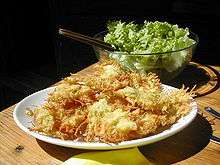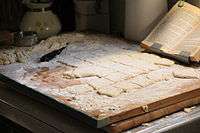Beignet
 Potato beignet from the Upper Savoy, France | |
| Alternative names | Many (see text) |
|---|---|
| Type | Pastry |
| Place of origin | France |
| Main ingredients | Dough, powdered sugar |
|
| |
Beignet (English pronunciation: /bɛnˈjeɪ/; French: [bɛɲɛ], literally bump),[1] synonymous with the English "fritter", is the French term for a pastry made from deep-fried choux pastry.[2] Beignets can also be made from other types of dough, including yeast dough.
The tradition of deep-frying fruits for a side dish dates to the time of Ancient Rome, while the tradition of beignets in Europe is speculated to have originated with a heavy influence of Islamic culinary tradition.[3] The term beignet can be applied to two varieties, depending on the type of pastry. The French-style beignet in the United States, has the specific meaning of deep-fried choux pastry.[4] Beignets can also be made with yeast pastry,[5] which might be called boules de Berlin in French, referring to Berliner doughnuts which have a spherical shape (i.e. they do not have the typical doughnut hole) filled with fruit or jam.
In Corsica, beignets made with chestnut flour (Beignets de farine de châtaigne) are known as fritelli.
Donuts in Quebec and elsewhere in Canada are referred to as both Beigne and Beignet in French.
New Orleans

.jpg)
Beignets are commonly known in New Orleans as a breakfast served with powdered sugar on top.[2] They are traditionally prepared right before consumption to be eaten fresh and hot. Variations of fried dough can be found across cuisines internationally; however, the origin of the term beignet is specifically French. In the United States, beignets have been popular within New Orleans Creole cuisine and are customarily served as a dessert or in some sweet variation. They were brought to New Orleans in the 18th century by French colonists,[5] from "the old mother country",[6] and became a large part of home-style Creole cooking, variations often including banana or plantain – popular fruits in the port city.[7][8] Today, Café du Monde is a popular New Orleans food destination specializing in beignets with powdered sugar, coffee with chicory, and café au lait.[9] Beignets were declared the official state doughnut of Louisiana in 1986.[10]
Preparation
Ingredients used to prepare beignets traditionally include:
- lukewarm water
- granulated sugar
- evaporated milk
- bread flour
- shortening
- oil or lard, for deep-frying
- confectioners' sugar
-

Beignets before frying
-
Piping choux pastry dough for beignets
See also
- Cuisine of New Orleans
- Loukoumades
- Sufganiyah
- Zeppole
- Mekitsa
- List of choux pastry dishes
- List of doughnut varieties
References
- ↑ Collins English Dictionary – Complete and Unabridged. HarperCollins Publishers. 2003.
- 1 2 Alan Davidson (1999) Oxford Companion to Food, Oxford University Press
- ↑ http://www.rachellaudan.com/2009/07/beignets-and-luqam-thoughts-from-cathy-kaufman.html
- ↑ Oxford Companion to Food, Alan Davidson [Oxford University Press:Oxford] 1999 (p.70)
- 1 2 http://whatscookingamerica.net/History/BeignetsHistory.htm
- ↑ Schneider, Wendi. The Picayune's Creole Cook Book. New York: Random House, 1989. p385. Print.
- ↑ McKnight, Laura. "Beignets: More than Just a Doughnut." HoumaToday.com. 16 Nov. 2007. Web.
- ↑ Philadelphia Inquirer. "Of Interest to Women: Banana Served In Appetizing Forms." America's Historical Newspapers. 1 Jan. 1907.
- ↑ http://www.cafedumonde.com/history.html
- ↑ http://www.statesymbolsusa.org/Louisiana/donut_beignet.html
Further reading
- Yves Thuriès, French Pastry, ISBN 0-471-28598-6
- Rosana G Moreira et al., Deep Fat Frying: Fundamentals and Applications, ISBN 0-8342-1321-4
External links
| Wikimedia Commons has media related to Beignets. |